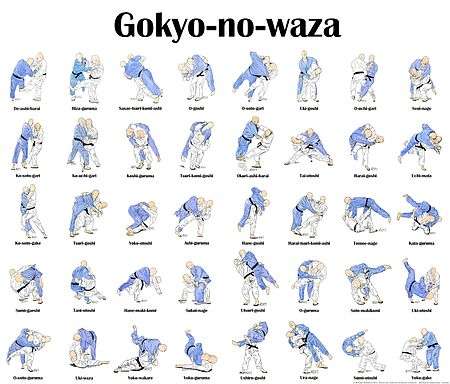List of Kodokan judo techniques
Like many other martial arts, Kodokan judo provides lists of techniques students must learn to earn rank. For a more complete list of judo techniques by technique classification, including Japanese kanji, see the article judo techniques.
Ukemi (breakfalls)
Students first learn how to fall, and must master the fall exercises before moving on to the throws lists.[1]
- Mae ukemi, forward fall.
- Ushiro ukemi, backward fall.
- Yoko ukemi, side fall (accompanied by hard slap of tatami mat).
- Mae Mawari Ukemi, forward judo roll.
Nage-waza (throwing techniques)

The 68 throws of Kodokan judo[2]
Dai ikkyo
(1st group)
- Deashi harai (or barai)
- Hiza guruma
- Sasae tsurikomi ashi
- Uki goshi
- Osoto gari (Major Outside Reap)
- O goshi
- Ouchi gari
- Seoi nage
Dai nikyo
(2nd group)
Dai sankyo
(3rd group)
Dai yonkyo
(4th group)
- Sumi gaeshi
- Tani otoshi
- Hane makikomi
- Sukui nage
- Utsuri goshi
- O guruma
- Soto makikomi
- Uki otoshi
Dai gokyo
(5th group)
Habukareta waza
(preserved techniques from 1895 gokyo)
Shinmeisho no waza
(newly accepted techniques in 1987, 1997 and 2017)
- Morote gari (双手刈)
- Kuchiki taoshi (朽木倒)
- Kibisu gaeshi (踵返)
- Uchi mata sukashi
- Tsubame gaeshi
- Kouchi gaeshi
- Ouchi gaeshi
- Osoto gaeshi
- Harai goshi gaeshi
- Uchi mata gaeshi
- Hane goshi gaeshi
- Kani basami
- Osoto makikomi
- Kawazu gake
- Harai makikomi
- Uchi mata makikomi
- Sode tsurikomi goshi
- Ippon seoinage
- Obi tori gaeshi
- Kouchi makikomi
- Daki age was excluded as a Kodokan officially recognized technique.
Katame-waza (grappling techniques)
The 32 official grappling techniques of Kodokan judo[3]
Osaekomi-waza
(pins / mat holds)
- Kuzure-kesa-gatame (崩袈裟固)
- Kata-gatame (肩固)
- Kami-shiho-gatame (上四方固)
- Kuzure-kami-shiho-gatame (崩上四方固)
- Yoko-shiho-gatame (横四方固)
- Tate-shiho-gatame (縦四方固)
- Kesa-gatame (袈裟固)
- Uki-gatame (浮固)(Added 2017)
- Ura-gatame (裏固)(Added 2017)
- Ushiro-kesa-gatame (後袈裟固)(Added 2017)
Shime-waza
(chokes or strangles)
- Nami-juji-jime (並十字絞)
- Gyaku-juji-jime (逆十字絞)
- Kata-juji-jime (片十字絞)
- Hadaka-jime (裸絞)
- Okuri-eri-jime (送襟絞)
- Kata-ha-jime (片羽絞)
- Do-jime (胴絞)
- Sode-guruma-jime (袖車絞)
- Kata-te-jime (片手絞)
- Ryo-te-jime (両手絞)
- Tsukkomi-jime (突込絞)
- Sankaku-jime (三角絞)
Kansetsu-waza
(joint locks)
- Ude-garami (腕緘)
- Ude-hishigi-juji-gatame (腕挫十字固)
- Ude-hishigi-ude-gatame (腕挫腕固)
- Ude-hishigi-hiza-gatame (腕挫膝固)
- Ude-hishigi-waki-gatame (腕挫腋固)
- Ude-hishigi-hara-gatame (腕挫腹固)
- Ashi-garami (足緘)
- Ude-hishigi-ashi-gatame (腕挫脚固)
- Ude-hishigi-te-gatame (腕挫手固)
- Ude-hishigi-sankaku-gatame (腕挫三角固)
Kinshi-waza (forbidden techniques)
These are techniques that have been removed from competition, mostly because of their high risk of injury.
- Ashi-garami (足緘)
- Do-jime (胴絞)
- Kani-basami (蟹挟)
- Kawazu-gake (河津掛)
gollark: That's actually pretty good because it's not copyable and impossible to fake.
gollark: I have one which uses asymmetric cryptography stuff - private key on the disk/card, public key stored... publicly - which means it doesn't need a server and can just pull off HTTP, but this is also neat.
gollark: Oh cool, a good keycard door lock program.
gollark: Obviously all this needs power, so there's a 16kRF/t TBU oxide reactor (machine-designed) on the left powering it. Thorium is supplied by the lens of the miner setup and it somehow runs net-positive.
gollark: The roof has an AE2 system glued to it which does the main crafting.
See also
References
- Falling Archived 2006-09-30 at the Wayback Machine
- Name of Judo Techniques
External links
- Judoinfo site
- JudoVideo—Reference for the Kodokan judo techniques
This article is issued from Wikipedia. The text is licensed under Creative Commons - Attribution - Sharealike. Additional terms may apply for the media files.